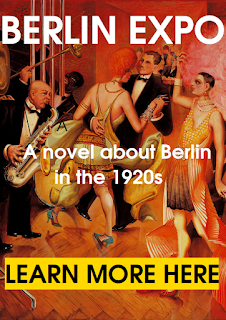Sportpalast (Palace of Sports)
is one of those emblematic
buildings of Berlin whose disappearance is to regret. It was
inaugurated in 1910 with a symphonic concert: the Beethoven’s Ninth
directed by Richard Strauss. It has long been the largest covered
hall in the city, with a capacity of ten thousand people.
In the 1920s, the palace experienced a boom with ice hockey and boxing. Boxing stars appeared, such as Hans Breitensträter (called: Hans the Blond) Sabri Mahir (The Terrible Turk) and Max Schmeling (called: Maxe). Enrico Caruso was often a spectator, as were Richard Tauber, Hans Albers, Fritz Kortner, Ernst Oppler and Bertolt Brecht.
In 1923, the world's first indoor equestrian tournament was held at the Palast.
Since 1911, the Six Days cycling races have been held as a major event, which has remained a Berlin tradition to this day. Well-to-do spectators instituted prices, such as villas or fur coats. At night, the race track became a dance floor.
In the 1920s, the palace experienced a boom with ice hockey and boxing. Boxing stars appeared, such as Hans Breitensträter (called: Hans the Blond) Sabri Mahir (The Terrible Turk) and Max Schmeling (called: Maxe). Enrico Caruso was often a spectator, as were Richard Tauber, Hans Albers, Fritz Kortner, Ernst Oppler and Bertolt Brecht.
In 1923, the world's first indoor equestrian tournament was held at the Palast.
Since 1911, the Six Days cycling races have been held as a major event, which has remained a Berlin tradition to this day. Well-to-do spectators instituted prices, such as villas or fur coats. At night, the race track became a dance floor.
But
the Sportpalast had a political importance too. It was more and more
favored by the big parties for their meetings. Leaders from right and
left delivered speeches at the Palace, such as Ernst Thälmann of the
Communist Party KPD, centrist Heinrich Brüning or Nazis like Hitler
and Goebbels. The latter often dishonored the Palace with his
eructations, the worst being perhaps his call for "total war"
of 1943.
An excerpt from Franz Hessel’s book « Promenades in Berlin » :
"Whoever
wants to see Berlin people in a fever, should not miss the chance to
see at least part of the 144 hours dedicated to those who ride on an
inclined wooden track, the six-day races. In the central circle and
the reserved boxes of the hall, one can see the cream of society and
the celebrities with their beautiful shoulders draped in Sable and
Fox fur.
But
it’s better to sit amongst the true connoisseurs, the
super-Berliners. No detail in the race, no change of lead is ignored,
everything is criticised or applauded in the most enthusiastic
fashion. If nothing worthwhile happens, they play cards. Then
resonate and whistle the names of favorites who are encouraged and
who, up here, are well known, without having to look at the number or
color of the shirt. Here you’ll meet a good-natured neighbor who
will explain you the phases of the course, the pursuit, the relays,
the penalty points, the sprints and the meaning of the luminous
signaling in green, blue and red. The Berliner explains it all with
pleasure, surprised to meet someone who does not know anything about
these things of such extreme importance that he knows since he was a
child. / ... /
Sport
is international and knows nothing about political parties. But its
palace is open to political passion. A great rally of the National
Socialists is announced. The rooms are filled. Before the doors, the
police patrols, because there is a counter-demonstration of the
"reds". Suddenly, one hears that the communists want to
break into the palace. The police receives reinforcements. The rubber
truncheons sway. It is difficult to verify who has started. If they
did not carry their symbols, the slogans of reaction or revolution,
one could scarcely distinguish these intrepid young Berliners from
both camps. Other times those in the steel helmet wait outside while
stalking while the reds are gathered inside. Then the room is full of
large red banners. The supervisors make sure that the stairs are
free. The crowd moves away meekly when the Red Front enters
accompanied by music. The music that excites the comrades is of a
warrior type. The very young boys advance by stirring the cymbals,
the flute players follow them. The raised fist of the men and the
open hands of the children greet the flags. »



No comments:
Post a Comment